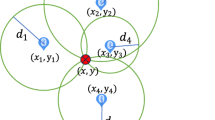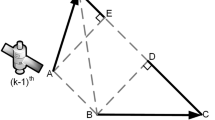Abstract
Secure localization in the presence of cheating anchors is a critical issue in wireless sensor networks, where compromised anchors attempt to falsify the measured distances in the location references. In this study, such misbehaviors of unfaithful anchors are modeled as unknown perturbations to the measured distances. By exploiting the sparsity of malicious anchors, the secure localization problem is formulated as a sparse signal recovery problem whose objective is to concurrently locate the sensors and identify the malicious anchors. Under the above formulation, the upper bound for the number of tolerable malicious anchors is obtained and the localization error bound is also provided. A gradient projection algorithm with variable step size is proposed to solve the sparse recovery problem. To further improve the localization accuracy, another modified gradient projection algorithm is presented. Simulation results show that the proposed algorithms can identify the unfaithful anchors with high probability and achieve good localization accuracy.







Similar content being viewed by others
References
Fang, S.-H., Chuang, C.-C., & Wang, C. (2012). Attack-resistant wireless localization using an inclusive disjunction model. IEEE Transactions on Communications, 60(5), 1209–1214.
Li, X., Chen, Y., Yang, J., & Zheng, X. (2011). Achieving robust wireless localization resilient to signal strength attacks. Wireless Networks, 18(1), 45–58.
Chen, H., Lou, W., Wang, Z., Wu, J., Wang, Z., & Xia, A. (2015). Securing DV-Hop localization against wormhole attacks in wireless sensor networks. Pervasive and Mobile Computing, 16, 22–35.
Sarigiannidis, P., Karapistoli, E., & Economides, A. A. (2015). Detecting Sybil attacks in wireless sensor networks using UWB ranging-based information. Expert Systems with Applications, 42(21), 7560–7572.
Boustani, A., Alamatsaz, N., Jadliwala, M., & Namboodiri, V. (2014). LocJam: A novel jamming-based approach to secure localization in wireless networks. In Consumer Communications and Networking Conference (CCNC), 2014 IEEE 11th (pp. 336–344). doi:10.1109/CCNC.2014.6866592.
Zeng, Y., Cao, J., Hong, J., Zhang, S., & Xie, L. (2013). Secure localization and location verification in wireless sensor networks: A survey. Journal of Supercomputing, 64(3), 685–701.
Milocco, R. H., & Boumerdassi, S. (2015). An efficient adaptive method for estimating the distance between mobile sensors. Wireless Networks, 21(8), 2519–2529.
Halder, S., & Ghosal, A. (2016). A survey on mobile anchor assisted localization techniques in wireless sensor networks. Wireless Networks, 22(7), 2317–2336.
Park, M.-H., Nam, K.-G., Kim, J. S., Yum, D. H., & Lee, P. J. (2013). Secure and lightweight localization method for wireless sensor networks. IEICE Transactions on Information and Systems, E, 96D(3), 723–726.
Liu, D., Ning, P., Liu, A., Wang, C., & Du, W. K. (2008). Attack-resistant location estimation in wireless sensor networks. ACM Transactions on Information and System Security, 11(4), 22:1–22:39.
Liu, D., Ning, P., & Du, W. (2005). Detecting malicious beacon nodes for secure location discovery in wireless sensor networks. In 25th IEEE International conference on distributed computing systems, 2005. ICDCS 2005. Proceedings, pp. 609–619. doi:10.1109/ICDCS.2005.21.
Chen, H., Lou, W., & Wang, Z. (2010). A novel secure localization approach in wireless sensor networks. Eurasip Journal on Wireless Communications and Networking, 2010, 981280.
Han, G., Jiang, J., Shu, L., Guizani, M., & Nishio, S. (2013). A two-step secure localization for wireless sensor networks. Computer Journal, 56(10), 1154–1166.
Zhu, W. T., Xiang, Y., Zhou, J., Deng, R. H., & Bao, F. (2011). Secure localization with attack detection in wireless sensor networks. International Journal of Information Security, 10(3), 155–171.
Garg, R., Varna, A. L., & Wu, M. (2012). An efficient gradient descent approach to secure localization in resource constrained wireless sensor networks. IEEE Transactions on Information Forensics and Security, 7(2), 717–730.
Li, Z., Trappe, W., Zhang, Y., & Nath, B. (2005). Robust statistical methods for securing wireless localization in sensor networks. In Fourth International Symposium on Information Processing in Sensor Networks, 2005. IPSN 2005 (pp. 91–98). doi:10.1109/IPSN.2005.1440903.
Misra, S., Xue, G., & Bhardwaj, S. (2009). Secure and robust localization in a wireless ad hoc environment. IEEE Transactions on Vehicular Technology, 58(3), 1480–1489.
Wang, D., & Yang, L. (2012). Cooperative robust localization against malicious anchors based on semi-definite programming. In Military Communications Conference, 2012—MILCOM 2012 (pp. 1–6). doi:10.1109/MILCOM.2012.6415656.
Elad, M. (2010). Sparse and redundant representations: From theory to applications in signal and image processing (1st ed.). Incorporated: Springer.
Jadliwala, M., Zhong, S., Upadhyaya, S., Qiao, C., & Hubaux, J.-P. (2010). Secure distance-based localization in the presence of cheating beacon nodes. IEEE Transactions on Mobile Computing, 9(6), 810–823.
Merkel, S., Mostaghim, S., & Schmeck, H. (2014). Hop count based distance estimation in mobile ad hoc networks—Challenges and consequences. Ad Hoc Networks, 15, 39–52.
Gurung, S., Hossain, A. K. M. M., & Kanchanasut, K. (2014). A hop-count based positioning algorithm for wireless ad-hoc networks. Wireless Networks, 20(6), 1431–1444.
Chen, H., Liu, B., Huang, P., Liang, J., & Gu, Y. (2012). Mobility-assisted node localization based on toa measurements without time synchronization in wireless sensor networks. Mobile Networks and Applications, 17(1), 90–99.
Zhang, W., Xu, H., & Yang, L. (2011). A novel \({\mathbf{\ell }}\)1-regularized LS formulation for target localization and malicious anchor identification. In Military Communications Conference, 201—MILCOM 201, pp. 766–771. doi:10.1109/MILCOM.2011.6127769.
Capkun, S., & Hubaux, J.-P. (2006). Secure positioning in wireless networks. IEEE Journal on Selected Areas in Communications, 24(2), 221–232.
Baraniuk, R. G. (2007). Compressive sensing [lecture notes]. IEEE Signal Processing Magazine, 24(4), 118–121.
Bertsekas, D. P. (1999). Nonlinear programming (2nd ed.). Cambridge, MA: Athena Scientific.
Figueiredo, M. A. T., Nowak, R. D., & Wright, S. J. (2007). Gradient projection for sparse reconstruction: Application to compressed sensing and other inverse problems. IEEE Journal of Selected Topics in Signal Processing, 1(4), 586–597.
Steven, M. K. (1993). Fundamentals of statistical processing, volume i: Estimation theory (1 edition.). Prentice Hall.
Chan, F. K. W., So, H. C., Zheng, J., & Lui, K. W. K. (2008). Best linear unbiased estimator approach for time-of-arrival based localisation. IET Signal Processing, 2(2), 156–162.
Acknowledgements
The authors would like to thank the anonymous reviewers and the associate editors for their valuable suggestions. This work has been supported by the National Natural Science Foundation of China under Grant No. 61371135.
Author information
Authors and Affiliations
Corresponding author
Ethics declarations
Conflict of interest
The authors declare that they have no conflict of interest.
Human participants or animals
The research does not involve any human participants or animals.
Informed consent
Informed consent has also been confirmed.
Rights and permissions
About this article
Cite this article
Zhang, Q., Wan, J., Wang, D. et al. Sparse recovery formulation for secure distance-based localization in the presence of cheating anchors. Wireless Netw 24, 2657–2668 (2018). https://doi.org/10.1007/s11276-017-1490-5
Published:
Issue Date:
DOI: https://doi.org/10.1007/s11276-017-1490-5




